How to Make St. John’s Wort Oil & Salve
Now that you’ve learned how to forage for St. John’s wort, let’s turn those flowers into an herbal oil and salve that’s helpful for tired muscles, sciatica, cold sores, shingles, or general aches and pains!
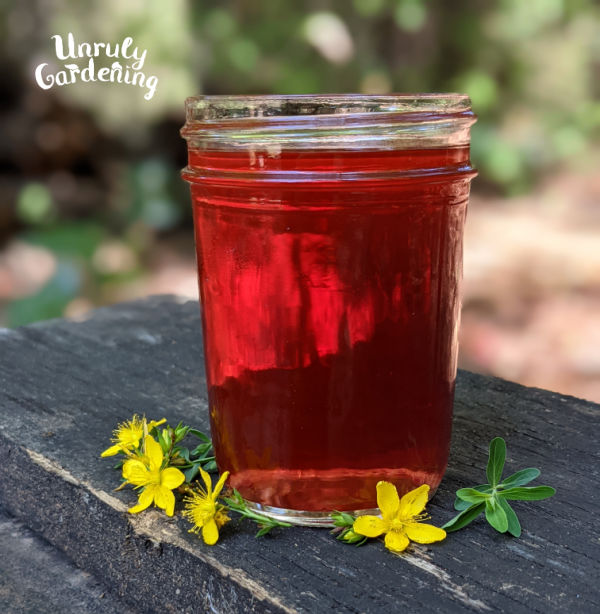
If you haven’t read up about collecting this sunny summer herb, check out our article:
Foraging St. John’s Wort: How To Identify And Harvest
St. John’s Wort Oil Recipe
While we often use dried herbs to make infused oils, in this case we need to use fresh or slightly wilted plant instead.
Once dried, St. John’s wort (Hypericum perforatum) loses a lot of the effective compounds that you want to infuse into the oil. (If you don’t have fresh St. John’s wort available though, never fear! You can buy the ready made oil at Mountain Rose Herbs.)
St. John’s wort oil is for external use only – don’t take this oil internally!
Ingredients for the oil:
To make St. John’s wort oil, you’ll need:
- fresh St. John’s wort (Hypericum perforatum) flowers and flowering tops
- oil of your choice (see below for options)
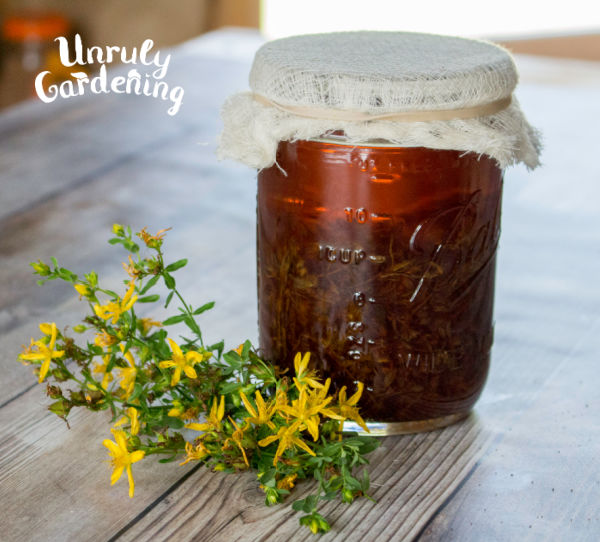
Directions to make the oil:
- Pick the flower buds and flowering tops (approximately the top 6 to 8 inches of the plant – this can include leaves and stems) and either use them right away, or spread them on a screen or paper towel for a few hours to slightly wilt them.
- Next, place the flowers in a glass canning jar and fill about 3/4 way. (If you have a lot of plant material use a quart or pint jar, if you only have a little plant material, use a half-pint or smaller jar.)
- Mash, chop, or bruise the flowers/flowering tops to expose more surface area to the oil. (We like to use a pair of scissors with blades placed down in the jar, so we can snip into pieces in the same container that we infuse in.)
- Pour your favorite oil into the jar, almost to the top. (See below for some options and tips.)
- Cover the top of the jar with a piece of cheesecloth or a coffee filter secured with a rubber band – to allow excess moisture to evaporate – and infuse for two weeks. The oil will turn a pretty shade of red as the beneficial components are infused into the oil.
- Some herbalists like to infuse St. John’s Wort in the sunlight, while others prefer a dark area. Both ways will work!
- Strain and let the oil settle for a day or two. You’ll likely notice a layer of residue settle to the bottom of the jar.
- Carefully pour the oil into a fresh clean jar, but leave behind that sludgy residue at the bottom of the infusing jar – this will help remove excess water and extend shelf life.
- Store the finished oil in a cool place. Many herbalists like to store the oil in the refrigerator to extend shelf life. If stored in a cool area and out of light, your oil should be good for at least 6 to 9 months, or longer. (Discard immediately if signs of mold, spoilage, or a bad smell develop.)
- Use the oil to make salves and creams. (Don’t use this oil internally or for food purposes.)
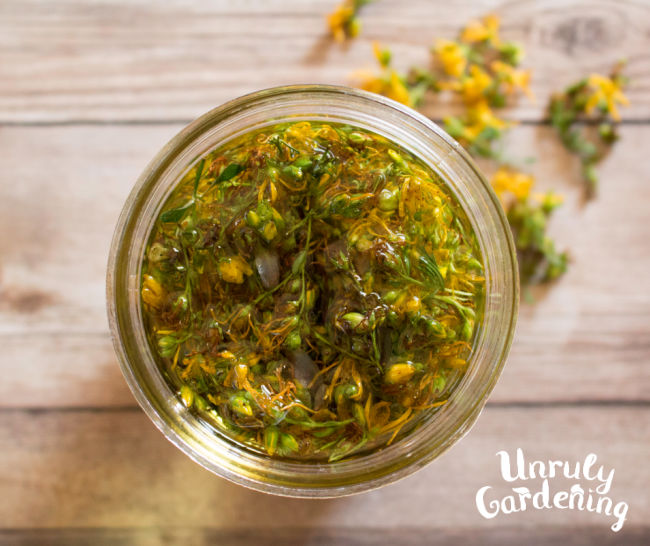
What kind of oil to use for St. John’s wort oil and salve:
The classic oil to use for herbal infusions is organic extra virgin olive oil – and this is completely fine to use. Sunflower is another good choice, especially for those prone to eczema or sensitive skin.
If you’d like a lighter feeling oil (which helps make a lighter feeling and less greasy salve), try using an oil that absorbs into your skin more quickly than olive, such as apricot kernel oil, jojoba oil, rice bran oil, or safflower oil.
You could also combine oils – including a small amount (about 0.25 to 0.5 oz) of a super light oil such as fractionated coconut oil (which is the kind still liquid when it gets cold) or grapeseed oil in your infusion will make the infused oil and resulting salve even lighter feeling.
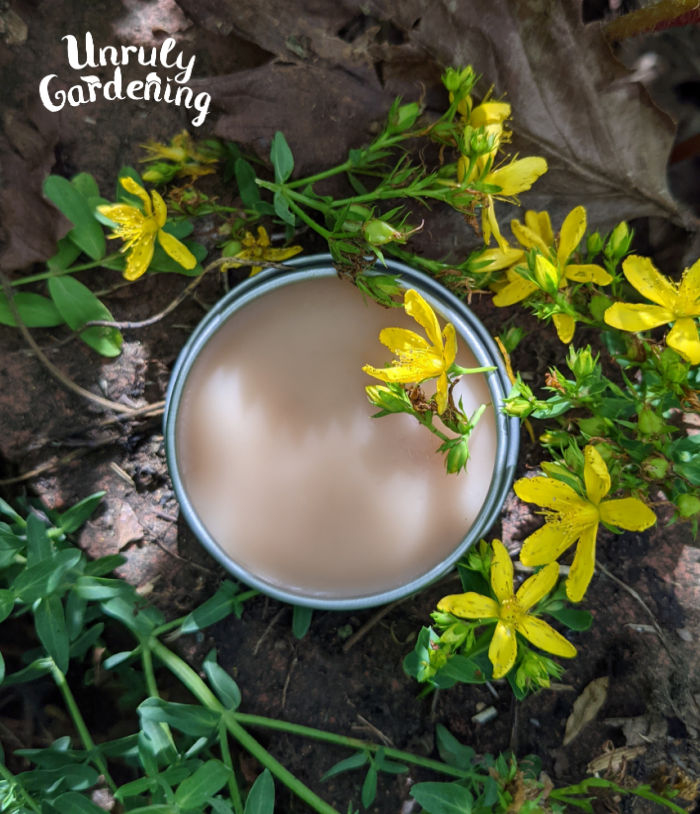
St. John’s Wort Salve Recipe
You can use all St. John’s Wort oil in this recipe to make an effective all-purpose basic salve, or you may wish to use part St. John’s wort oil and part of another kind of herbal infused oil.
For pain relief or sore muscles, try combing with dandelion, goldenrod, or arnica flower. (Example: Instead of 3.5 oz St. John’s wort oil, you could use 2 oz St. John’s wort oil and 1.5 oz of arnica.)
If you’re making a salve for shingles or cold sores, try combining with lemon balm which is an herb specifically helpful for the herpes virus. (Example: 2 oz St. John’s wort oil and 1.5 oz lemon balm infused oil.)
Free free to get creative with the recipe and make it your own!
Ingredients for the salve:
Measurements are by weight; you’ll need a kitchen scale to make this salve.
- 3.5 oz (99 g) St. John’s wort infused oil
- 0.5 oz (14 g) beeswax (grated or pastilles)
- up to 48 drops of essential oil (see essential oils section below)
Directions for the salve:
- Weigh the infused oil and beeswax into a heatproof jar. (For easy cleanup, you could also use an empty tin can.)
- Place the jar down into a small saucepan filled with a few inches of water, forming a makeshift double boiler.
- Place the pan over a medium-low burner until the wax is melted.
- Remove from heat and let the mixture cool a few minutes then stir in the essential oils, if using.
- Pour into tins or glass jars. This recipe fills about 2 1/2 two-ounce tins.
Essential oil options for St. John’s wort salve:
- Leave out the essential oils if using on your lips, or add 10 drops of peppermint essential oil (for scent & cooling sensation) and optionally, 2 drops of clove bud essential oil (for pain relief).
- Leave out the essential oils if making an all purpose healing salve for using on wounds, scrapes, rashes and other itchy skin conditions, and general first aid.
- Cooling pain relief salve (2% dilution rate): 30 drops peppermint essential oil, plus 10 drops juniper berry (or cedarwood or fir needle) essential oil, plus 8 drops rosemary essential oil.
- Warming pain relief salve (2% dilution rate): 30 drops cypress, 10 drops juniper berry, fir needle, or cedarwood, plus 8 drops rosemary or lavender essential oil.
Our articles are for information and idea-sharing only. While we aim for 100% accuracy, it is solely up to the reader to provide proper identification. Be sure to seek out local foraging classes and plant walks, and invest in mushroom and foraging guides suitable for the area you live in, since some wild foods are poisonous, or may have adverse effect.
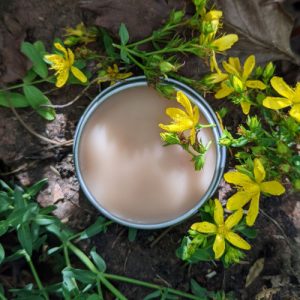
St. John’s Wort Oil & Salve
Equipment
- 1 canning jar for infusing (use half pint jar for small amount of herb, use a pint or quart if you have a lot of herb)
- a square of folded cheesecloth, old scrap t-shirt, or coffee filter
- 1 rubber band
- kitchen scale
- small saucepan
- tins or jars for the salve (fills about 2 1/2 two-ounce tins; you could also pour the salve into a half-pint jar, or repurposed jelly jar)
Ingredients
For the Infused Oil
- fresh St. John's wort flowers
- oil of your choice (olive, sunflower, rice bran, apricot kernel oil, etc)
For the Salve
- 3.5 oz St. John's wort infused oil
- 0.5 oz beeswax (grated or pastilles)
- up to 48 drops essential oil (2% dilution rate) – optional, see notes below
Instructions
To make the infused oil:
- Pick the flower buds and flowering tops (approximately the top 6 to 8 inches of the plant – this can include leaves and stems) and either use them right away, or spread them on a screen or paper towel for a few hours to slightly wilt them.
- Next, place the flowers in a glass canning jar and fill about 3/4 way.
- Mash, chop, or bruise the flowers/flowering tops to expose more surface area to the oil. (We like to use a pair of scissors with blades placed down in the jar, so we can snip into pieces in the same container that we infuse in.)
- Pour your favorite oil into the jar, almost to the top. (If in doubt about what kind to use, you can't go wrong with olive or sunflower oil.)
- Cover the top of the jar with a piece of cheesecloth or a coffee filter secured with a rubber band – to allow excess moisture to evaporate – and infuse for two weeks. The oil will turn a pretty shade of red as the beneficial components are infused into the oil.
- Some herbalists like to infuse St. John’s Wort in the sunlight, while others prefer a dark area. Both ways will work!
- Strain after two weeks and let the oil settle for a day or two. You’ll likely notice a layer of residue settle to the bottom of the jar.
- Carefully pour the oil into a fresh clean jar, but leave behind that sludgy residue at the bottom of the infusing jar – this will help remove excess water and extend shelf life.
- Store the finished oil in a cool place. Many herbalists like to store the oil in the refrigerator to extend shelf life. If stored in a cool area and out of light, your oil should be good for at least 6 to 9 months, or longer. (Discard immediately if signs of mold, spoilage, or a bad smell develop.)
- Use the oil to make salves and creams. (Don’t use this oil internally or for food purposes.)
To make the salve:
- Weigh the infused oil and beeswax into a heatproof jar or container. (For easy cleanup, you could also use an empty tin can.)
- Place the jar down into a small saucepan filled with a few inches of water, forming a makeshift double boiler.
- Place the pan over a medium-low burner until the wax is melted.
- Remove from heat and let the mixture cool a few minutes then stir in the essential oils, if using.
- Pour into tins or glass jars. This recipe fills about 2 1/2 two-ounce tins, or you could pour the salve into a clean half-pint jar or repurposed jelly jar.
Notes
Essential oil options for St. John’s wort salve:
- Leave out the essential oils if using on your lips, or add 10 drops of peppermint essential oil (for scent & cooling sensation) and optionally, 2 drops of clove bud essential oil (for pain relief).
- Leave out the essential oils if making an all purpose healing salve for using on wounds, scrapes, rashes and other itchy skin conditions, and general first aid.
- Cooling pain relief salve (2% dilution rate): 30 drops peppermint essential oil, plus 10 drops juniper berry (or cedarwood or fir needle) essential oil, plus 8 drops rosemary essential oil.
- Warming pain relief salve (2% dilution rate): 30 drops cypress, 10 drops juniper berry, fir needle, or cedarwood, plus 8 drops rosemary or lavender essential oil.

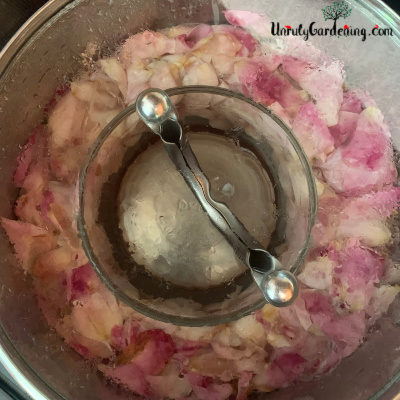
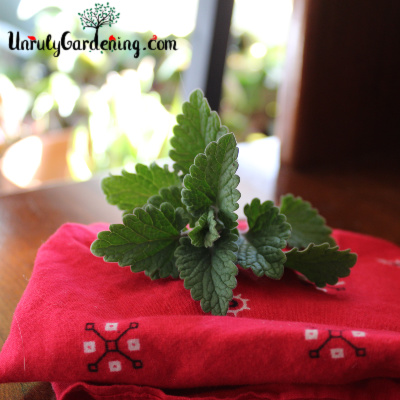
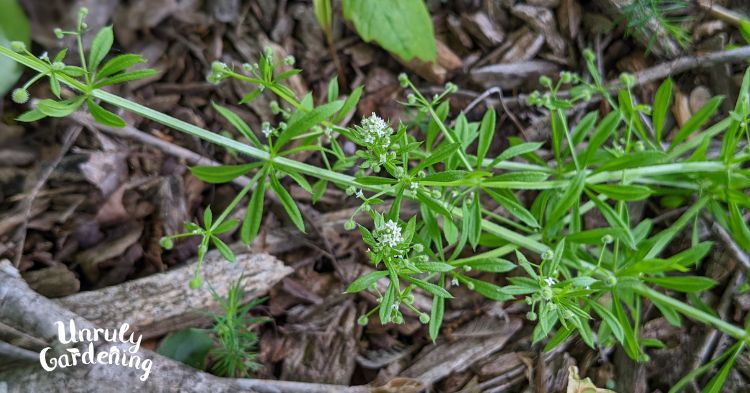
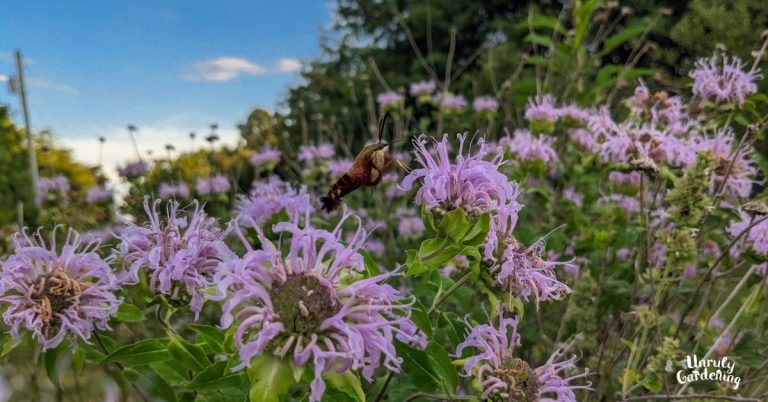
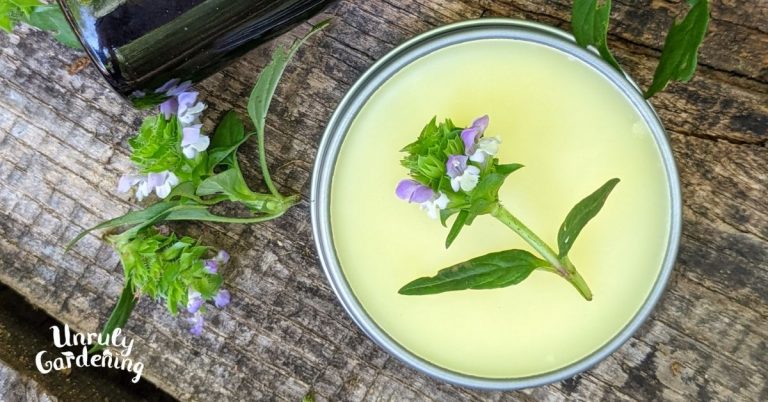
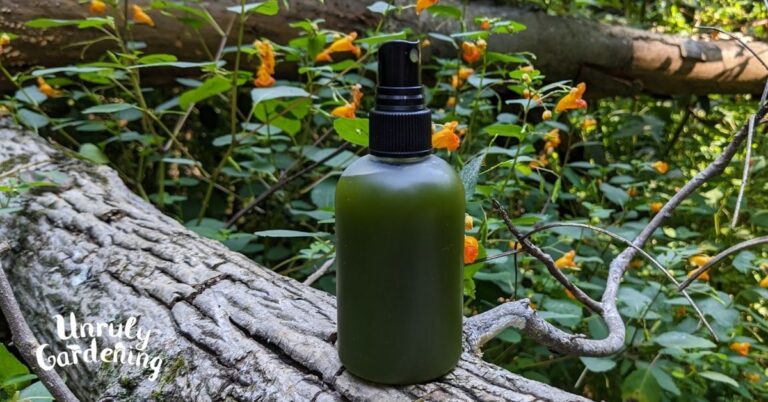
My SJW oil never turned red. Can I still use it?
Hi Christianne! Were your flowers fresh when you made the oil? Dried St John’s Wort won’t really turn red, so you need fresh or freshly wilted.
If you did use fresh flowers – are you 100% sure that it’s a Saint John’s Wort plant?
If you have a photo of the fresh flowers and/or leaves you used, you can email it to unrulygardening @ gmail . com and I can take a look to make sure you don’t have a different plant.
Hi Jan, I just made a St. Johnswort salve using infused olive oil. It was a nice red until I added beeswax when it lightened to a tannish color. So I looked it up and saw your picture – also tan! Next I’ll have to see how it works on nerve pain.
Also I wanted to say that last year I used flowers from a bush I bought at a local native nursery, but the oil never turned red. So it must’ve been a cultivar. This year I foraged from the wild “weedy” type growing on my property, and yup, that turned red! Lesson learned!
Hi Alice! So glad you were able to make the salve & hope it works well for you! I remember the first time I made salve with my beautiful red oil and it turned tan! I thought I’d done something wrong, but that’s just what it does. 🙂
Hi there i have had some St johns wort infusing for 4 months looksa intensely red and smells wonderfully fresh…Whats the longest period it can be infused for.I am going to strain it this week.
Hi Moon, As long as it looks and smells good, your oil should be fine! I often forget to strain my oils for a few months too. 🙂 If you’re dealing with dried herbs and they stay completely covered in oil, then you could go a whole year without straining. Fresh herbs can’t handle as long before they start spoiling, but it sounds like you caught yours in time!